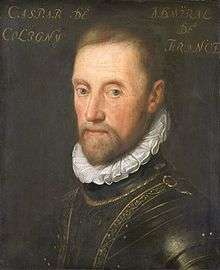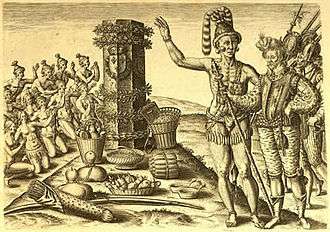Gaspard II de Coligny
Gaspard de Coligny, Seigneur de Châtillon (16 February 1519 – 24 August 1572), was a French nobleman and Admiral of France, best remembered as a disciplined Huguenot leader in the French Wars of Religion and a close friend of—and advisor to—the French king, Charles IX.
Gaspard II de Coligny | |
|---|---|
| Seigneur de Châtillon | |
 Portrait by Jan van Ravesteyn | |
| Titles and styles | |
| Born | 16 February 1519 Châtillon-sur-Loing, Kingdom of France |
| Died | 24 August 1572 (aged 53) Paris, Kingdom of France |
| Family | Coligny |
| Spouse(s) | |
Issue
| |
| Father | Gaspard I de Coligny |
| Mother | Louise de Montmorency |
Biography
Ancestry
Coligny came of a noble family of Burgundy. His family traced their descent from the 11th century, and in the reign of Louis XI, were in the service of the King of France. His father, Gaspard I de Coligny, known as the 'Marshal of Châtillon', served in the Italian Wars from 1494 to 1516, married in 1514, and was created Marshal of France in 1516. By his wife, Louise de Montmorency, sister of the future constable, he had three sons, all of whom played an important part in the first period of the Wars of Religion: Odet, Gaspard and François.
Early life
Born at Châtillon-sur-Loing in 1519, Gaspard came to court at the age of 22 and began a friendship with François of Guise. In the campaign of 1543 Coligny distinguished himself, and was wounded at the sieges of Montmédy and Bains. In 1544 he served in the Italian campaigns under the Count of Enghien, King Charles VIII, King Louis XII, King Francis I and was knighted on the Field of Ceresole. Returning to France, he took part in different military operations; and having been made colonel-general of the infantry (April 1547), exhibited great capacity and intelligence as a military reformer.
That year he married Charlotte de Laval (d. 1568). He was made admiral on the death of Claude d'Annebaut (1552). In 1557 he was entrusted with the defence of Saint-Quentin. In the siege he displayed great courage, resolution, and strength of character; but the place was taken, and he was imprisoned in the stronghold of L'Ecluse. On payment of a ransom of 50,000 crowns he recovered his liberty.
By this time he had become a Huguenot, through the influence of his brother, d'Andelot. The first known letter which John Calvin addressed to him is dated 4 September 1558. The Coligny brothers were the most zealous and consistent aristocratic supporters of Protestantism in sixteenth-century France.
Establishment of Huguenot colonies

Gaspard de Coligny secretly focused on protecting his co-religionists, by attempting to establish colonies abroad in which Huguenots could find a refuge. He organized the expedition of a colony of Huguenots to Brazil, under the leadership of his friend and navy colleague, Vice-Admiral Nicolas Durand de Villegaignon, who established the colony of France Antarctique in Rio de Janeiro, in 1555. They were afterwards expelled by the Portuguese, in 1567.
Coligny also was the leading patron for the failed French colony of Fort Caroline in Spanish Florida led by Jean Ribault in 1562.
In 1566 and 1570, Francisque and André d'Albaigne submitted to Coligny projects for establishing relations with the Austral lands. Although he gave favourable consideration to these initiatives, they came to naught when Coligny was killed in 1572 during the St. Bartholomew's Day massacres.[1]
National conflicts
Following the death of Henry II he placed himself with Louis, Prince of Condé, at the forefront of the Huguenot party, and demanded religious toleration and certain other reforms. In 1560, at the Assembly of Notables at Fontainebleau, the hostility between Coligny and François of Guise broke forth violently. When the civil wars began in 1562, Coligny decided to take arms only after long hesitation, and remained always ready to negotiate. In none of these wars did he show superior genius, but he acted throughout with great prudence and extraordinary tenacity; he was "le héros de la mauvaise fortune" ("hero of misfortune")
In the "first war" of 1562–63 he commanded the cavalry at the Battle of Dreux, the first major engagement and, unlike both commanders in chief, managed to avoid being captured, and withdrew in good order from the defeat. He was blamed by the Guise faction for the assassination of Francis, Duke of Guise at Orléans in 1563.
In the "third war" of 1569 the defeat and death of the Prince of Condé at the Battle of Jarnac left Coligny the sole leader of the Protestant armies. Victorious at the Battle of La Roche-l'Abeille, but defeated in the Battle of Moncontour on 3 October, he entered into the negotiations for what became the Peace of Saint-Germain (1570). Marrying Jacqueline de Montbel d'Entremont, and returning to court in 1571, he grew rapidly in favour with Charles IX, becoming a close mentor to the weak, easily manipulated King.
As a means of emancipating the king from the tutelage of his mother and the faction of the Guises, the admiral proposed to him a descent on Spanish Flanders, with an army drawn from both faiths and commanded by Charles in person. The king's regard for the admiral and the increasingly bold demands of the Huguenots alarmed Catherine de' Medici, the Queen Mother.

Assassination and massacre
The wedding of the Protestant Henry, King of Navarre, and Marguerite de Valois, the King's sister, brought a great number of Huguenot notables to Paris, and political and religious tensions were running extremely high. On 22 August 1572, the day after the end of the wedding festivities, Coligny was shot in the street by a man called Maurevert from a house belonging to de Guise. However, the bullets only tore a finger from his right hand and shattered his left elbow. The would-be assassin escaped.
It never became clear who, if anyone, had hired or encouraged Maurevert to carry out the attempt but historians generally centre on three possibilities: the Guise family, Catherine de Medici, or the duke of Alba on behalf of Philip II of Spain.[2] The King sent his own physician to treat Coligny and even visited him, but the queen mother prevented all private discourse between them.
The Catholics now feared Huguenot retaliation for the attempt on Coligny's life, and it was decided to pre-emptively assassinate their leadership, in what became known as the St. Bartholomew's Day massacre. As one of the main targets, on the night of 24 August, Coligny was attacked in his lodgings by a group led by Guise. After several of his entourage had been killed, a servant of the new Duke of Guise, Charles Danowitz or Jean Charles D´Ianowitz (Karel z Janovic), who was generally known as Besme or Bême, plunged a sword through Coligny's breast and threw his body out of a window to his master's feet. Coligny finally died when another of Guise's associates chopped off his head.

Historian Barbara B. Diefendorf wrote that Simon Vigor had "said if the King ordered the Admiral (Coligny) killed, 'it would be wicked not to kill him'. With these words, the most popular preacher in Paris legitimised in advance the events of St. Bartholomew's Day."[3]

Coligny's papers were seized and burned by the queen mother; among them, according to Brantôme, was a history of the civil war, "very fair and well-written, and worthy of publication".
Marriages and issue
By his first wife, Charlotte de Laval (1530–1568), Gaspard had several children:
- Louise, who married first Charles de Téligny and afterwards William the Silent, Prince of Orange;
- François, Admiral of Guienne, who was one of the devoted servants of Henry IV (Gaspard de Coligny (1584–1646), son of this François, was Marshal of France during the reign of Louis XIII); and
- Charles (1564–1632), Marquis d'Andelot, a Lieutenant General in Champagne.
By his second wife, Jacqueline de Montbel d'Entremont (1541–1588), the Countess d'Entremont and Launay-Gelin, Gaspard had one daughter, Beatrice, who became Beatrice de Coligny (born 1572), Countess d'Entremont.
Legacy
Several places are named after de Coligny:
- Coligny, South Africa
- Fort Coligny, in Rio de Janeiro, Brazil
- Châtillon-Coligny, in France
- Coligny Plaza, Hilton Head Island
- Coligni (misspelled) Avenue, New Rochelle, New York
Family tree
Notes
- E.T. Hamy, "Francisque et Andre d'Albaigne: cosmographes lucquois au service de la France"; "Nouveau documents sur les frères d'Albaigne et sur le projet de voyage et de découvertes présenté à la cour de France"; and "Documents relatifs à un projet d’expéditions lointaines présentés à la cour de France en 1570", in Bulletin de Géographie Historique et Descriptive, Paris, 1894, pp.405–433; 1899, pp.101–110; and 1903, pp.266–273.
- Lord Acton, in "The Huguenots and the League", p. 159, blamed Catherine and the Guise family.
- Diefendorf, B. B. (1991). Beneath The Cross: Catholics & Huguenots in Sixteenth Century Paris. Oxford University Press. p. 157. ISBN 0-19-506554-9.
- Note that the birth date here differs from the one provided by Encyclopædia Britannica in the lead paragraph
References
- Jean du Bouchet, Preuves de l'histoire généalogique de l'illustre maison de Coligny (Paris, 1661)
- François Hotman, Vita Colinii (1575), translated as La vie de messire Gaspar de Colligny Admiral de France, (1643; facsimile edition prepared by Émile-V. Telle (Geneva: Droz) 1987).
- L. J. Delaborde, Gaspard de Coligny (1879–1882)
- Erich Marcks, Gaspard von Coligny, sein Leben und das Frankreich seiner Zeit (Stuttgart, 1892)
- H. Patry, "Coligny et la Papauté," in the Bulletin du protestantisme français (1902)
- Arthur Whiston Whitehead, Gaspard de Coligny, Admiral of France (1904)
- Charles Merki, L'Amiral de Coligny (1909).
- J. Shimizu, Conflict of Loyalties: Politics and Religion in the Career of Gaspard de Coligny, Admiral of France, 1519–1572 (Geneva) 1970. Coligny's political motivations are stressed.
- A Paris colloquy on Admiral de Coligny and his times in 1972 resulted in a volume of essays, Actes du colloque l'Amiral de Coligny et son temps (Paris) 1974.

Sources
| Wikimedia Commons has media related to Gaspard de Coligny. |
- GeneaNet Genealogical database
- L'Amiral Coligny, Martyr Huguenot: Sermon par Alfred V. Wittmeyer bilingual commemorative sermon from 1925
- Encyclopædia Britannica